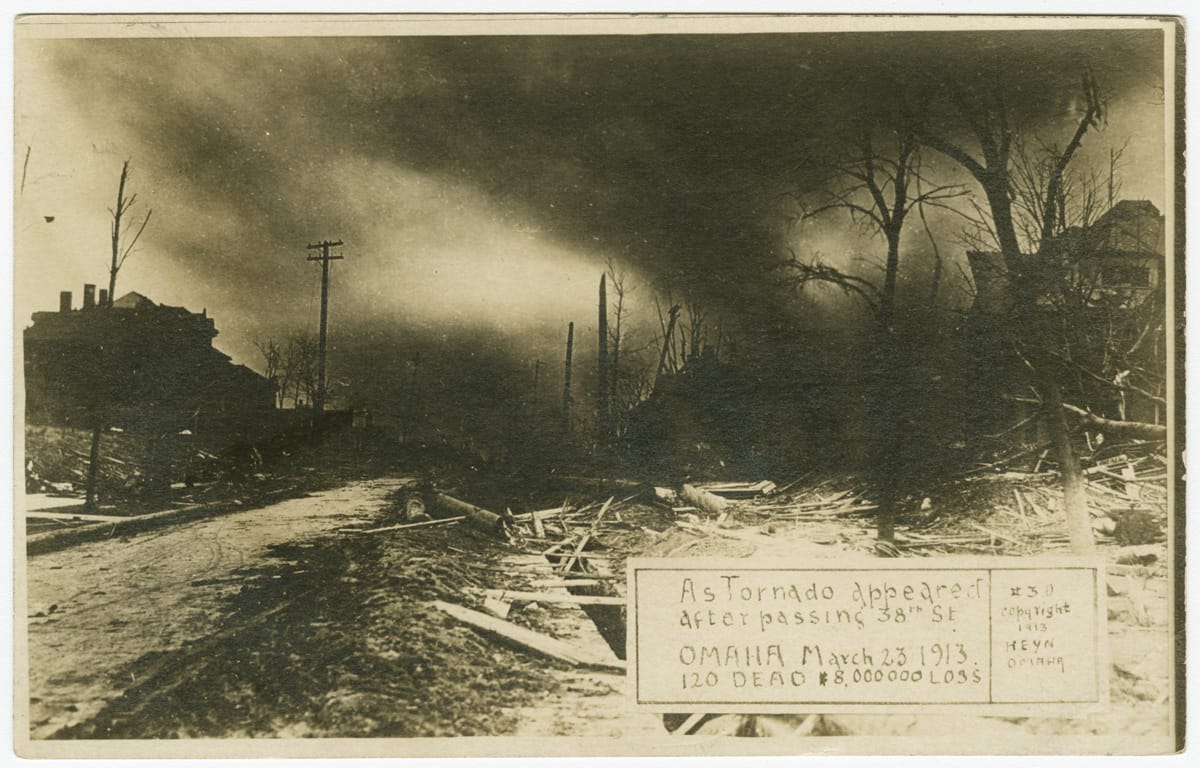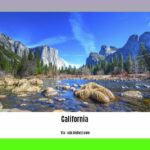Nebraska, the heartland of America, evokes images of vast plains and rolling farmland. But this picturesque landscape also lies within an area known as “Tornado Alley,” a region where the clash of air masses often spawns powerful tornadoes. Let’s journey through Nebraska’s tornado history, exploring its infamous twisters and understanding the forces that shape these destructive storms.
History of Tornadoes in Nebraska
Nebraska’s history is interwoven with tales of tornadoes, some leaving behind scars of destruction that linger to this day. One such event, etched in the collective memory of Nebraskans, is the devastating Omaha Easter Sunday Tornado of 1913. This monstrous twister tore through the heart of Omaha, leaving a path of devastation in its wake. The storm claimed the lives of 103 people, making it one of the deadliest tornadoes in Nebraska’s history.
The 1913 Omaha Tornado serves as a tragic reminder of the immense power of tornadoes. However, it also reveals the resilience of the people of Nebraska. Following the disaster, Omaha rebuilt, emerging stronger and more prepared for future storms. This spirit of perseverance echoes throughout the state’s history.
Since that fateful Easter Sunday, Nebraska has continued to experience the raw force of tornadoes, averaging around 50 twisters annually. However, advancements in weather forecasting and warning systems have significantly reduced the number of fatalities. It’s a testament to scientific progress that since 1953, no single tornado in Nebraska has resulted in more than 10 deaths.
For those seeking a deeper understanding of Nebraska’s tempestuous relationship with tornadoes, the National Oceanic and Atmospheric Administration (NOAA) offers a fascinating resource: the Tornado Archive. This comprehensive database chronicles the history of tornadoes across the United States, including detailed records for Nebraska. Researchers, weather enthusiasts, and anyone curious about these powerful storms can delve into the archive to uncover patterns, trends, and historical insights. The NOAA’s Tornado Archive stands as a testament to our evolving understanding of tornadoes and our ongoing efforts to mitigate their impact.
How often does Nebraska get tornadoes?
Nebraska’s location in the heart of Tornado Alley puts it directly in the path of frequent tornado activity. While the frequency can vary from year to year, Nebraska averages between 50 to 60 tornadoes annually, a number comparable to its Tornado Alley neighbors like Illinois, Iowa, Oklahoma, and Colorado.
When is Tornado Season in Nebraska?
Tornado season in Nebraska typically aligns with the spring and summer months, with May and June being the most active. During this time, warm, moist air from the Gulf of Mexico flows northward, colliding with cooler, drier air pushing down from the Rocky Mountains. This clash of air masses creates instability in the atmosphere, often triggering severe thunderstorms and tornadoes.
While spring and summer see the highest concentration of tornadoes, Nebraska can also experience these storms in the fall. These autumn tornadoes are often associated with the remnants of tropical storms or hurricanes moving north from the Gulf of Mexico.
Where do most tornadoes occur in Nebraska?
Eastern Nebraska, particularly the southeastern part of the state, experiences a higher frequency of tornadoes compared to the western regions. The closer proximity to the warm, humid air masses from the Gulf of Mexico contributes to the increased tornado risk in these areas.
Understanding the frequency and timing of tornadoes in Nebraska is vital for residents. This knowledge empowers individuals and communities to prepare effectively, ensuring they have safety plans in place and access to timely weather warnings.
Key Takeaways:
- Nebraska averages 50-60 tornadoes per year.
- May and June are prime time for tornadoes.
- Fall tornadoes are possible, often influenced by tropical systems.
- Eastern Nebraska gets more tornadoes than the west.
- Knowing when tornadoes are most likely to occur helps you stay safe.
When was the last time Nebraska had a tornado?
While the frequency of tornadoes in Nebraska paints a picture of their regularity, it’s natural to wonder about the most recent events. Nebraska’s last significant tornado outbreak occurred on December 15, 2021, a date that etched itself into the state’s weather history. An unprecedented 22 tornadoes touched down across the state, shattering the previous record for the most tornadoes in Nebraska during December.
More recently, a smaller EF-1 tornado occurred near Petersburg on June 10, 2023. This tornado, while significantly weaker than the 2021 outbreak, serves as a reminder that tornadoes can occur outside the typical peak season.
Nebraska’s experience underscores the unpredictable nature of tornadoes, emphasizing the importance of year-round preparedness. The state’s history, marked by both devastating outbreaks and isolated events, highlights the need for continued vigilance and a deep understanding of tornado safety.
Let’s recap some key facts about tornadoes in Nebraska:
- On average, Nebraska sees around 26 tornadoes annually.
- The eastern counties, especially those hugging the state border, tend to be tornado hotspots.
- That record-breaking outbreak on December 15, 2021, really highlights how unpredictable tornadoes can be.
- While most Nebraska tornadoes are thankfully on the weaker side (EF-0 or EF-1), the state has seen its share of stronger, more destructive twisters.
Keep in mind that our understanding of tornadoes is always evolving. Scientists are constantly researching these powerful storms to improve forecasting and warning systems.
When was the last EF5 tornado in Nebraska?
The Enhanced Fujita Scale (EF Scale) categorizes tornadoes based on their wind speed and potential for damage. An EF5 tornado, the highest rating on the scale, is a rare and catastrophic event.
Nebraska’s last encounter with an EF5 tornado dates back to May 5, 1964. This monstrous twister carved a path of destruction nearly 70 miles long through Adams and Butler Counties. The 1964 event remains the only recorded EF5 tornado in Nebraska’s history.
Since that devastating day in 1964, no other tornadoes in Nebraska have reached the terrifying intensity of an EF5. Most tornadoes that have impacted the state since 1950 have fallen between EF0 and EF3 on the scale, significantly weaker than their notorious predecessor.
The absence of EF5 tornadoes in Nebraska since 1964 is likely due to a complex interplay of factors that are not fully understood. Tornadoes are influenced by a delicate balance of atmospheric conditions, and the specific elements required to produce an EF5 may not have aligned in the same way since 1964.
Here are a few things we do know:
- The 1964 EF5 tornado was a rare event. EF5 tornadoes are incredibly uncommon anywhere in the world. They require a very specific and powerful combination of atmospheric conditions to form.
- Tornado forecasting has improved significantly since 1964. While predicting the exact intensity of a tornado is still a work in progress, meteorologists are much better equipped today to warn people of potential tornado threats, giving them valuable time to seek shelter.
While the future occurrence of EF5 tornadoes in Nebraska remains uncertain, ongoing research and advancements in forecasting offer hope for better preparedness and mitigation strategies.
What county in Nebraska has the most tornadoes?
While tornadoes can occur across Nebraska, certain counties experience a higher frequency due to their geographic location and the specific atmospheric conditions that favor tornado development.
Hall County, home to the city of Grand Island, holds the unfortunate distinction of having the highest concentration of tornadoes in Nebraska. Since 1950, Hall County has averaged approximately 5.8 tornadoes for every 10,000 square miles, placing it among the most tornado-prone areas in the entire United States.
Custer County, located in west-central Nebraska, holds a different kind of record – having the highest number of recorded tornadoes since the year 2000. With 43 confirmed twisters, Custer County’s tornado activity highlights the unpredictable nature of these storms and how they can impact different regions of the state.
Other counties in Nebraska that have experienced a significant number of tornadoes include:
- Franklin County: 9 tornadoes since 2000.
- Banner County: 12 tornadoes since 2000.
- Pawnee County: 7 tornadoes since 2000.
The distribution of tornadoes across Nebraska underscores the importance of statewide preparedness. While some counties may experience a higher frequency of tornadoes, all residents of Nebraska should be aware of the risks and take necessary precautions.
Who has more tornadoes: Kansas or Nebraska?
Kansas and Nebraska, both situated within Tornado Alley, are well-acquainted with the threat of tornadoes. However, Kansas holds the title for the higher average number of tornadoes annually. According to the National Oceanic and Atmospheric Administration (NOAA), Kansas averages a staggering 96 tornadoes each year. This makes Kansas the state with the second-highest average number of tornadoes in the United States.
Nebraska, while still prone to these powerful storms, typically experiences between 51 and 66 tornadoes per year.
The higher frequency of tornadoes in Kansas is likely attributed to its central location within Tornado Alley and its slightly larger geographical size compared to Nebraska. However, both states face significant risks from these storms and require robust preparedness measures.
It’s important to remember that these are just averages, and tornado activity can fluctuate significantly from year to year. Both Kansas and Nebraska have experienced periods of heightened tornado activity, highlighting the unpredictable nature of these storms.
Why does Nebraska get so many tornados?
Nebraska’s unenviable position in the heart of Tornado Alley makes it a prime target for these powerful storms. This region, stretching from Texas northward through the Great Plains, experiences a unique confluence of atmospheric conditions that create a breeding ground for tornadoes.
The Perfect Storm: Geography and Weather Patterns
Nebraska’s susceptibility to tornadoes boils down to a combination of its geographical location and prevailing weather patterns. Here’s a closer look at the key factors:
- Clash of Air Masses: Warm, moist air sweeping up from the Gulf of Mexico collides with cold, dry air descending from the Rocky Mountains. This clash of air masses creates instability in the atmosphere, a key ingredient for tornado formation.
- Flat Terrain: The vast, flat plains of Nebraska allow for unobstructed airflow, providing a clear path for these colliding air masses to meet and interact.
- Wind Shear: Wind shear, the change in wind speed and direction with height, is crucial for tornado development. Nebraska’s location often experiences strong wind shear, which can cause air to rotate horizontally and potentially develop into a tornado.
Nebraska vs. Its Neighbors
While Nebraska experiences a significant number of tornadoes, it’s worth noting that some of its neighbors in Tornado Alley, such as Texas, Kansas, and Oklahoma, typically report even higher numbers. This difference can be attributed to variations in geographic size, the specific paths of storm systems, and slight nuances in atmospheric conditions.
Tornado Alley: Is it Shifting?
Intriguingly, there’s ongoing discussion among scientists about a potential eastward shift of Tornado Alley. Some researchers suggest that areas in the Southeast, particularly along the Gulf Coast, are experiencing an increase in tornado activity. While the reasons for this potential shift are still under investigation, climate change and its influence on atmospheric patterns are considered to be contributing factors.
Staying Safe in Tornado Country
Living in Tornado Alley requires vigilance and preparedness. Here are some essential steps to stay safe during tornado season:
- Stay Informed: Monitor weather forecasts regularly, especially during peak tornado season. Sign up for weather alerts and pay attention to watches and warnings.
- Have a Plan: Develop a family tornado plan, including designated safe spaces within your home, evacuation routes, and communication strategies.
- Prepare a Kit: Assemble an emergency kit with essential supplies such as water, non-perishable food, a first aid kit, a weather radio, and flashlights.
- Know Your Risk: Research the historical tornado activity in your area and understand the specific risks associated with your location.
What are the top 3 states for tornado occurrence?
When it comes to tornadoes, three states consistently rank at the top for the highest number of twisters annually:
- Texas: Often referred to as the “Lone Star State” and the largest state in the contiguous United States, Texas takes the top spot for tornado occurrence. Its sprawling size, location within Tornado Alley, and proximity to the Gulf of Mexico make it a prime target for these powerful storms.
- Oklahoma: Situated in the heart of Tornado Alley, Oklahoma has earned a reputation for experiencing some of the most powerful and destructive tornadoes in history. Its flat terrain and frequent clash of warm, moist air from the south with cool, dry air from the north contribute to its high tornado risk.
- Kansas: Known for its vast wheat fields and as the “Sunflower State,” Kansas rounds out the top three for tornado frequency. Like its neighbors Texas and Oklahoma, Kansas sits squarely within Tornado Alley and experiences a similar confluence of atmospheric conditions that favor tornado development.
While these three states consistently dominate the top rankings, it’s essential to remember that tornadoes can occur in all 50 states.
Is Tornado Alley Shifting?
Recent data and ongoing research suggest a potential eastward shift of Tornado Alley. This shift, while still under investigation, is leading to an increase in tornado activity in states like Mississippi, Alabama, and even parts of the Southeast that are not traditionally considered part of Tornado Alley. This potential shift highlights the dynamic nature of weather patterns and the need for continued research and adaptation in tornado preparedness.
How big was the Nebraska tornado in 2024?
The Nebraska tornado of 2024, a powerful EF3 on the Enhanced Fujita Scale, left a path of destruction across the state, underscoring the devastating impact these storms can have.
A Devastating Force
With wind speeds reaching up to 136 miles per hour, the 2024 tornado ripped through communities, leaving behind a trail of debris and destruction. Homes were flattened, businesses were damaged, and power lines were toppled.
The western suburbs of Omaha were particularly hard hit, with hundreds of homes sustaining damage. Images from the aftermath revealed the sheer force of the storm, showcasing the resilience required of those who live in Tornado Alley.
Part of a Larger Outbreak
The 2024 Nebraska tornado was not an isolated event. It was part of a larger outbreak of severe weather that spawned a staggering 92 confirmed tornadoes across Nebraska, Iowa, and several other states. This widespread outbreak demonstrated the interconnectedness of weather patterns and the potential for large-scale impacts.
A Stark Reminder
The 2024 Nebraska tornado served as a stark reminder of the ever-present threat of tornadoes, even in areas accustomed to severe weather. It underscored the importance of preparedness, early warning systems, and community resilience in the face of natural disasters.
While meteorologists have made significant strides in tornado forecasting, predicting the exact path and intensity of these storms remains a challenge. Continued research into tornado dynamics and advancements in warning systems are crucial for minimizing the impact of these powerful forces of nature.
What states have never had tornadoes?
While the United States is known for experiencing a significant number of tornadoes annually, there are a few states that have never officially recorded a tornado. These states, often located far from the traditional Tornado Alley, enjoy a unique combination of geographic location and climatic conditions that make them less susceptible to these powerful storms.
The four states that have never experienced a confirmed tornado are:
- Alaska: Alaska’s northern location and generally cold climate make it an unlikely candidate for tornado development. While Alaska does experience thunderstorms, the specific atmospheric conditions required for tornadoes, such as warm, moist air, are less common.
- Hawaii: As an archipelago in the central Pacific Ocean, Hawaii’s tropical climate and isolation from mainland weather patterns make it largely immune to tornadoes. While Hawaii does experience other severe weather events, such as hurricanes and tropical storms, tornadoes are extremely rare.
- Maine: Located in New England, Maine benefits from its coastal location and generally cooler climate, which reduces the likelihood of tornadoes. While Maine can experience thunderstorms, the specific atmospheric ingredients needed for tornadoes are less likely to converge in this region.
- Rhode Island: The smallest state in the U.S., Rhode Island’s coastal location and relatively small size mean that the specific atmospheric conditions required for tornadoes are less likely to develop.
States with Very Few Tornadoes
In addition to the four states that have never recorded a tornado, several other states experience these storms very infrequently. These states include:
- Delaware
- Massachusetts
- Washington, D.C.
These states may experience an occasional tornado, often weaker in intensity, due to their proximity to areas with a higher tornado risk. However, their overall frequency remains significantly lower than states situated within Tornado Alley.
The absence of tornadoes in these states underscores the role of geography, climate, and atmospheric patterns in shaping these powerful storms.
Do tornadoes hit Omaha, Nebraska?
Omaha, Nebraska, like many cities located within the Great Plains region of the United States, is susceptible to tornadoes. Its location within Tornado Alley means that the city has experienced these powerful storms throughout its history. While tornadoes are not an everyday occurrence in Omaha, they are a reality for residents and a risk factor that necessitates preparedness.
Omaha’s History with Tornadoes
Omaha has weathered its fair share of tornadoes, with at least two dozen documented twisters impacting the city over the years. These tornadoes have varied in intensity and impact, but they serve as a reminder that Omaha is not immune to the destructive power of these storms.
One notable tornado, a stark example of the risks Omaha faces, struck the city’s suburbs on April 26, 2024. This tornado ripped through communities, damaging hundreds of homes and leaving behind a trail of debris and disruption. The 2024 event served as a tragic reminder of the importance of tornado preparedness and the unpredictable nature of these storms.
While tornadoes are a possibility anywhere in Nebraska, Omaha’s location in the eastern part of the state places it within an area that experiences a higher frequency of tornadoes compared to the western regions. This is due, in part, to Omaha’s closer proximity to the warm, moist air masses that fuel tornado development.
Staying Safe in Omaha
Living in Omaha, or any city within Tornado Alley, requires a proactive approach to tornado safety. Here are some essential steps residents can take:
- Be Aware: Stay informed about weather forecasts and tornado watches and warnings.
- Have a Plan: Develop a family tornado plan, including designated safe spaces within your home, evacuation routes, and communication strategies.
- Practice Drills: Regularly practice tornado drills with family members to ensure everyone knows what to do in the event of a warning.
- Stay Informed: Follow local news and weather alerts for up-to-date information on approaching storms.
Looking to learn more about the fascinating world of toby mugs? Discover the rich history behind these traditional drinking vessels by clicking here: history of toby mugs. In addition, if you’re interested in the history of typography, delve into the captivating story behind the Univers typeface by clicking here: history of univers typeface.
















